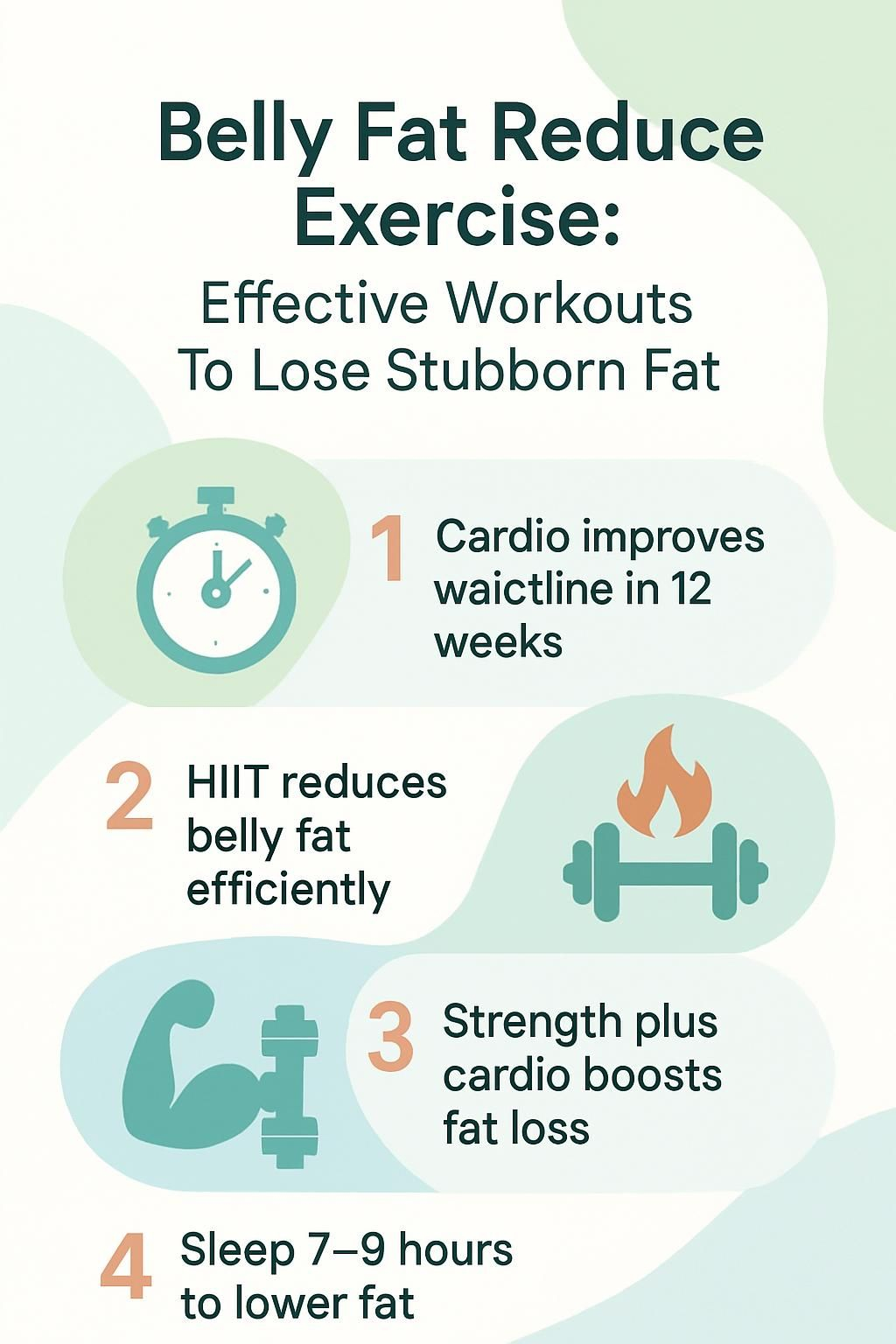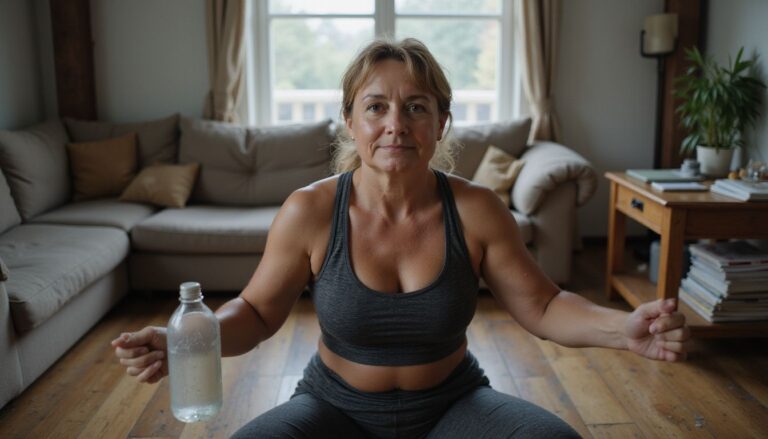Belly Fat Reduce Exercise: Effective Workouts To Lose Stubborn Fat
Our Nutrition Assistant AI Suite will transform your body. You will lose fat, get toned, and build muscle. Gain confidence and optimal health.
Struggling with stubborn belly fat can feel discouraging. The extra visceral fat around your abdomen raises the risk of type 2 diabetes and heart problems. This guide on belly fat reduce exercise shows you which workouts, habits, and simple nutrition shifts actually help you lose fat and build strength.
You will learn how cardio, strength training, and core work fit together. Practical tips and research-backed advice make the path clear, even if your schedule is busy.
Key Takeaways
- Cardio workouts like running, cycling, swimming, and dancing burn calories and can reduce visceral belly fat. Several studies report clear waistline changes in about 12 weeks.
- Resistance training builds lean muscle mass. More muscle raises your resting metabolism and supports lasting fat loss.
- High-Intensity Interval Training, or HIIT, trims more belly fat in less time than steady cardio. Recent research links HIIT to greater reductions in deep abdominal fat.
- Combining strength and cardio beats either alone for stubborn fat. Harvard and the American College of Sports Medicine report stronger results with this mix.
- Getting 7 to 9 hours of sleep helps manage cortisol, a stress hormone, and supports recovery. Adults sleeping under 6 hours face higher belly fat risk.

Types and Impact of Belly Fat

Belly fat collects in different layers. Knowing the difference helps you target the right habits.
What Are the Differences Between Subcutaneous and Visceral Fat?
Subcutaneous fat sits just under your skin. You can pinch it on your belly, thighs, or arms. It stores energy and insulates the body, but it is usually less risky for health.
Visceral fat lies deeper in the abdomen, wrapping around the liver, pancreas, and intestines. This type disrupts hormones and organ function. Higher levels raise the risk of heart disease, insulin resistance, and high blood pressure.
Visceral fat is more dangerous because of its location near vital organs. People with large amounts face a greater chance of chronic disease linked to poor diet quality and inactivity.
Why Is Belly Fat So Hard to Lose?
Belly fat is stubborn because your body treats it like long-term energy storage. As muscle mass drops with age, metabolism slows. Fewer calories burn at rest and fat loss gets harder.
Cortisol, often called the stress hormone, can drive fat storage around the abdomen. Poor sleep and high stress make this worse. Many people also lose fat from other areas first, which makes the waistline look unchanged at the start.
Building muscle works like upgrading your calorie-burning engine. Resistance training plus a healthy diet higher in protein and lower in added sugar helps shift body composition.
What Health Risks Come with Excess Belly Fat?
Excess abdominal fat, especially visceral fat, increases the risk of high blood pressure, unhealthy cholesterol, and type 2 diabetes. It also raises the chance of sleep apnea and heart disease.
Research shows that reducing belly fat improves blood vessel function and sleep quality. If your body mass index is in the overweight or obese range, the risks climb even higher. Watching your waist size is a simple way to track health changes.
Can You Reduce Belly Fat in Specific Areas?
Many people hope to target belly fat. The body does not work that way, but smart training still reshapes your midsection.
Is Spot Reduction a Myth?
Spot reduction is a myth. Doing only ab exercises will not remove fat from your waist. Fat loss requires a calorie deficit, which means burning more calories than you eat.
As you create that deficit, your body loses fat from many places, not just one area. Genetics and hormones influence where fat leaves first. A smarter plan combines full-body strength training, cardio or HIIT, and consistent nutrition choices.
How Does Fat Loss Actually Work?
Fat loss happens when your body uses more energy than it takes in through food and drinks. Stored fat breaks into fatty acids and glycerol, which your muscles and organs use for fuel during activity.
Cardio, strength training, and a lower-carb approach can help you create a calorie deficit. Muscle tissue burns more calories at rest, so building it matters. Health professionals recommend at least 150 minutes of moderate activity each week.
Cutting sweetened beverages, walking daily, and increasing protein can create steady change. As visceral fat drops, risk for cardiovascular disease and insulin resistance declines. Long-term success comes from simple habits, good sleep, stress control, and nutrient-rich meals.
Effective Cardio Workouts to Burn Belly Fat
Cardio raises your heart rate and helps you burn more calories. Think of it as the engine that keeps fat loss moving.
How Does Running or Jogging Help Reduce Belly Fat?
Running or jogging supports a calorie deficit and can reduce visceral fat. Research shows that 30 to 60 minutes at a moderate pace on most days lowers body weight and waist size.
These workouts use large muscle groups and increase energy burn during and after training. Pair consistent jogging with simple nutrition shifts, such as fewer sugary drinks, for faster progress.
Can Swimming Help Burn Belly Fat?
Swimming is a joint-friendly aerobic exercise that burns significant calories. A 155-pound person can burn about 223 calories in 30 minutes of moderate swimming, according to Harvard data.
Water creates resistance, so you recruit many muscles in the arms, legs, and core. Consistent swimming sessions also help manage stress, which may lower cortisol and support belly fat loss.
Is Cycling Effective for Losing Belly Fat?
Cycling keeps a steady heart rate, which helps break down both surface fat and deeper visceral fat. Riding at 12 to 14 miles per hour for 30 minutes can burn over 250 calories for a 155-pound person.
Both outdoor and stationary bikes work well. Combine cycling with a plant-forward or lower-fat meal pattern to support fat loss and protect the liver as visceral fat declines.
How Does Dancing Contribute to Fat Loss?
Dancing is a fun way to get your heart rate up and burn calories. A 155-pound person can burn about 223 to 266 calories in 30 minutes of fast styles like Zumba or hip-hop.
It needs no special gear, just space and music. Regular sessions can help reduce both subcutaneous and visceral fat over time.
What Are Good Walking Tips for Beginners?
Brisk walking improves heart health and helps reduce belly fat. Aim for at least 30 minutes a day.
- Choose supportive shoes to protect joints and keep good posture.
- Start on flat routes, then add hills once you feel ready.
- Walk at a pace where you can talk but not sing, about 3 to 4 mph.
- Swing your arms to raise calorie burn and engage the core.
- Carry water to stay hydrated and help manage appetite.
- Have a protein-rich snack after, such as Greek yogurt or eggs.
- Track steps with a pedometer or phone; 8,000 to 10,000 daily supports weight goals^1^.
- Pause midway for simple strength moves like squats or kettlebell swings.
- Sleep 7 to 9 hours nightly to aid recovery and curb cravings.
As your base improves, add intervals or hills to keep progress going.
^1 Tudor-Locke C et al., Medicine & Science in Sports & Exercise, 2011
Strength Training for Belly Fat Reduction
Strength training builds muscle, which helps you burn more calories around the clock.
What Are the Benefits of Resistance Training?
Resistance training increases lean muscle mass. Muscle tissue uses more energy than fat, even when you rest. That means a higher daily calorie burn and better long-term fat loss.
People who add weight training to their routines often lose more body fat than those doing cardio alone. My own progress sped up after adding squats three times per week. Good form and steady effort matter more than lifting the heaviest weight.
Which Strength Exercises Target Belly Fat?
Use compound moves that work many muscles at once. These create the biggest calorie burn in less time.
- Squats train large muscle groups and raise metabolism. Start with bodyweight, then add load.
- Lunges hit legs and core. Try 10 per side and build up.
- Bicep curls support upper-body balance when paired with compound moves.
- Tricep kickbacks help, but combine them with squats or rows for better impact.
- Push-ups challenge chest, arms, and core in each rep.
- Deadlifts recruit the back and legs, boosting post-workout calorie burn.
- Planks strengthen deep core muscles. Hold with firm form for best results.
Research suggests regular strength work plus smart eating reduces visceral fat more than cardio alone. Limiting alcohol supports liver health and may reduce central fat gain.
How Can You Safely Incorporate Weights?
Begin with lighter weights and aim for 12 controlled reps. As form improves, raise the weight and lower the reps. Rest between sets to avoid strain.
Focus on technique during compound lifts like squats and deadlifts. If you have pain or medical conditions, check with a healthcare professional before starting. Progress gradually to prevent injury.
High-Intensity Interval Training (HIIT)
Short bursts of effort followed by brief rests can drive faster results in less time.
What Is HIIT and How Does It Work?
HIIT alternates hard efforts with easy recovery. For example, sprint or do fast squats for 30 seconds, then jog or rest for 30 seconds.
These intervals push your heart rate higher than steady cardio. Studies show you continue burning more calories after the workout ends. Sessions often last 15 to 30 minutes, which fits busy schedules.
What Are Sample HIIT Workouts for Belly Fat?
Try this bodyweight circuit three times per week.
- Jumping jacks, 30 seconds.
- Burpees, 30 seconds.
- Push-ups, 30 seconds.
- Squat jumps, 30 seconds.
- High knees, 30 seconds.
- Rest 60 seconds; repeat the circuit four times.
- Avoid alcohol before training to protect performance and recovery.
Adjust work and rest times to match your fitness level. Keep movements crisp and safe.
Why Is HIIT Effective for Fat Burning?
HIIT keeps your heart rate high during short bursts, which raises calorie burn during and after the session. Recent research links HIIT to larger drops in visceral fat compared with steady cardio.
The American College of Sports Medicine notes HIIT improves aerobic fitness and aids fat loss. Many people see stronger results using two or three short HIIT sessions each week.
Targeted Core Exercises for a Stronger Midsection
Core training builds stability, supports your spine, and improves daily movement.
How Do Planks Help Strengthen the Core?
Planks work the entire core, including deep stabilizers. Hold a plank for up to 60 seconds with a straight line from head to heels.
This exercise trains the abs, obliques, hips, back, and shoulders at once. Research shows planks often engage more muscles than basic crunches, which supports posture and balance.
What Are Mountain Climbers and Their Benefits?
Start in a plank. Drive one knee toward your chest, then switch quickly. Aim for 15 to 20 reps per side.
Mountain climbers raise your heart rate and challenge the core, shoulders, and legs. They are a simple way to blend cardio with core strength.
How Do Russian Twists Target Belly Fat?
Sit tall, lean back slightly, and twist your torso side to side. This move hits the obliques and lower abs while improving control and balance.
Dynamic core exercises like this can activate more abdominal muscles than simple crunches. Try 3 sets of 15 reps, three times weekly.
Why Are Bicycle Crunches Effective?
Bicycle crunches work the abs and obliques together. The elbow-to-knee motion increases muscle activation and raises heart rate.
Studies show bicycle crunches are among the most effective classic ab moves. Focus on slow, controlled twists for better form and less neck strain.
How Do Leg Raises Improve Core Strength?
Lying leg raises target the lower abs. Keep legs straight as you lift, pause, then lower without touching the floor.
Complete 10 to 15 reps with a flat back and tight core. Controlled reps protect the spine and build endurance.
Yoga and Pilates for Belly Fat Reduction
Gentle mind-body work can calm stress and strengthen deep core muscles.
How Does Yoga Help Manage Stress and Reduce Fat?
Yoga lowers cortisol through breathing and slow, steady movement. In a 12-week program, people often report less stress and smaller waistlines.
Adding simple poses like Child’s Pose or Legs-Up-The-Wall after workouts can aid recovery. Even ten minutes daily supports sleep and calmer eating patterns.
How Does Pilates Improve Core Strength and Posture?
Pilates focuses on controlled movements that target deep abdominal muscles such as the transverse abdominis. Sessions include planks, roll-ups, and the hundred.
Research shows regular Pilates improves posture and core strength within eight weeks. I noticed less back discomfort and better sitting posture after two weekly sessions on a mat.
How Can You Maximize Your Workout Results?
Small changes compound over time. Use the steps below to keep momentum.
Why Combine Cardio and Strength Training?
Cardio burns calories, while strength training builds muscle that burns more calories at rest. Together they protect muscle during weight loss and improve health markers.
A balanced routine makes it easier to lose stubborn belly fat while building fitness you can feel in daily life.
How to Stay Consistent and Increase Intensity Safely?
Consistency beats perfection. Plan your week and raise challenge levels slowly.
- Set workout appointments on your calendar.
- Track sessions in an app or notebook to see progress.
- Add about 5 percent more distance or weight every two weeks.
- Watch for fatigue or pain and schedule rest as needed.
- Rotate activities like biking, swimming, or dancing to prevent boredom.
- Celebrate small wins, such as one extra set or a longer jog.
- Prioritize 7 to 9 hours of sleep for recovery and performance.
- Choose protein-rich, lower-sugar meals to support training.
- Reflect on wins weekly to keep motivation strong.
Gradual progress helps you avoid injury and stay consistent for months, not days.
What Role Does Sleep Play in Recovery?
Sleep repairs muscle tissue and balances hormones. Adults sleeping fewer than 6 hours often show higher cortisol, which makes fat loss harder.
Aim for 7 to 9 hours most nights to support recovery, performance, and steady fat loss. If sleep issues persist, consider speaking with a healthcare professional.
How Does Diet Affect Belly Fat Reduction?
Food choices can speed up or slow down your results. Simple, steady changes work best.
Why Eat a High-Protein, Low-Sugar Diet?
Higher protein helps you feel full and protects muscle during fat loss. Lower sugar intake reduces spikes in insulin, a hormone that drives fat storage.
Studies show low-carb, higher-protein diets can lead to greater fat loss while preserving lean tissue. Try options like chicken, fish, eggs, beans, and Greek yogurt.
How Do Soluble Fiber and Healthy Fats Help?
Soluble fiber absorbs water and slows digestion, which helps you stay full. Healthy fats from avocados, olive oil, nuts, and fatty fish stabilize blood sugar.
- About 10 grams of soluble fiber per day links to lower visceral fat over time.
- Unsaturated fats improve cholesterol and support heart health.
- Fiber-rich meals can reduce calories absorbed and curb cravings.
- Healthy fats help your body absorb vitamins A, D, E, and K.
Adding oats and chia seeds to breakfast helped me reduce snacking between meals and stay on track.
Why Avoid Processed Foods and Sugary Drinks?
Processed snacks often contain trans fats, added sugars, and excess sodium. These ingredients make it easier to gain belly fat and raise disease risk.
Sugary drinks add calories without fullness. A 12-ounce soda packs about 39 grams of sugar. After cutting soda and packaged snacks for two months, my waist shrank and workouts felt easier.
Lifestyle Changes That Support Fat Loss
Daily habits shape your results. A few steady shifts can make a big difference.
How Can Reducing Stress Help Belly Fat Loss?
High stress can raise cortisol and trigger belly fat storage. Practices like deep breathing, meditation, and regular movement help lower stress levels.
Even a short walk or time with friends can calm cravings linked to stress eating. If stress feels unmanageable, consider support from a mental health professional.
Why Is Staying Hydrated Important?
Water supports metabolism, temperature control, and digestion. One study found that drinking 500 milliliters of water increased metabolic rate for about an hour.
During exercise, even a 2 percent drop in body weight from sweat reduces performance. Keep a water bottle nearby to stay consistent.
How to Track Progress and Set Realistic Goals?
Tracking gives you feedback you can act on. The scale is helpful, but not the only tool.
- Measure waist size weekly at the same spot. Many aim for under 35 inches for women and under 40 inches for men.
- Notice how clothes fit, not just the number on the scale.
- Set small goals, such as losing half a pound per week or one inch per month.
- Log workouts and meals to spot helpful patterns.
- Take front, side, and back photos every two weeks.
- Track energy, stamina, and sleep quality as extra signs of progress.
- Review and adjust goals monthly based on results.
Measuring my waist each Sunday helped me see progress even during slow weeks.
What Common Mistakes Should You Avoid When Losing Belly Fat?
A few common errors can stall progress. Avoid these and your efforts go further.
Why Is Overtraining Harmful?
Too much training or too few rest days can raise cortisol and increase belly fat. Overtraining also raises injury risk and weakens your immune system.
Plan rest days, watch for fatigue, and scale workouts when needed. Recovery helps drive results, not just effort.
What Are the Risks of Only Doing Ab Exercises?
Only doing ab moves does not spot reduce belly fat. Without cardio and full-body strength work, calorie burn stays too low.
Core muscles may strengthen under a layer of fat. Mix cardio, strength training, and nutrition to see your midsection change.
Why Is Nutrition Crucial for Fat Loss?
Eating fewer calories than you burn triggers the body to use stored fat. Higher protein helps preserve muscle, and fewer processed foods improve insulin control.
Balanced diets support long-term weight management and reduce risks tied to excess abdominal fat, according to the National Institutes of Health. Whole foods and mindful portions are a powerful combination.
Conclusion
Losing stubborn belly fat takes a clear plan and steady effort. Combine cardio, strength training, and core exercises to burn more calories during the day and at rest. Support training with protein-rich meals, fewer added sugars, and enough soluble fiber and healthy fats.
Protect progress with quality sleep and stress management. Track simple metrics like waist size and step count to stay motivated. With consistent action, you can reduce belly fat, improve heart health, and feel stronger week by week.
Health disclaimer: If you have a medical condition, are pregnant, or are new to exercise, talk with a qualified healthcare professional before starting a new workout or diet plan.
FAQs
1. What are the most effective workouts to reduce belly fat?
Aerobic activities such as brisk walking, cycling, and swimming help burn calories and target stubborn fat. Resistance training, including weight lifting and bodyweight exercises, increases muscle mass and boosts metabolism. High-intensity interval training, or HIIT, alternates short bursts of intense activity with rest and has shown strong results in reducing abdominal fat according to studies from the Journal of Obesity.
2. Can spot reduction exercises, like sit-ups, help lose belly fat?
Spot reduction is not supported by scientific evidence. Research published in the Strength and Conditioning Journal shows that exercises like sit-ups strengthen abdominal muscles but do not directly burn fat in that area. Whole-body workouts and a balanced diet are more effective for fat loss.
3. How often should I exercise to see results in belly fat reduction?
Experts recommend at least 150 minutes of moderate aerobic activity or 75 minutes of vigorous activity per week, combined with two days of strength training. Consistency is key. In my own experience, following this routine for three months led to noticeable changes in waist size and overall fitness.
4. What role does nutrition play in losing stubborn belly fat?
Nutrition plays a critical role. Consuming fewer calories than you burn, eating more fiber-rich foods, and limiting added sugars support fat loss. A table from the National Institutes of Health shows that diets high in whole grains and lean proteins are linked to lower abdominal fat levels.
Summary: Effective belly fat reduction combines aerobic exercise, resistance training, and high-intensity intervals with proper nutrition. Spot reduction is not effective; instead, focus on overall fat loss and healthy habits for lasting results.







